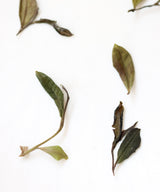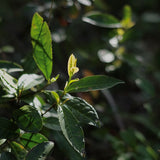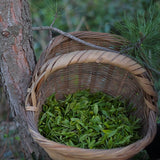Wild Laoshan White
野放崂山白茶
Harvest
May 2020
Origin
Laoshan, Qingdao
This Wild Laoshan White is a special “Reserve” release from the Tang family; only a few kilos were crafted in 2020, a small portion of which we are extremely grateful to have acquired.
Mr. Tang’s family are generational tea farmers in Laoshan Mountain of Qingdao, Shandong. Shandong, of Northeastern China, is named after Mount Lao, a magnificent mountain range recognized by its striking, slim, elongated cliffs. The many small plots that make up Mr. Tang’s tea farm are scattered along this coastline, at the foot of Mount Lao. Some are distributed right along the beaches, exposed to the salty wind that blows off of the water, while others are tucked slightly up into the forested hills, protected by the pine trees and the mountain behind them.
Laoshan is a very unique tea producing area in China. It is as far North as a tea region can be, and at the highest latitude, before temperatures become too cold for tea trees to survive.
The small farms in Laoshan have Mount Lao on one side, and are otherwise surrounded by ocean. The air here has very high humidity, and it sees longer winters of frost and snow than tea regions further South. Another special feature of Laoshan is that the water that irrigates the tea trees comes from natural springs that run through Mount Lao. This water is very pure and high in the minerals it collects from the cliffs of the mountain.
This tea comes from a once deserted tea garden that the Tang family came across, tucked into the forested hills at the foot of Mount Lao. Here, the smell of the ocean gives way to dense red pines and cherry trees laced with honeysuckle vines. The Tang family recognized this special tea garden for its particular peace and tranquility.
The tea trees here are around 30 years old, and were abandoned about a decade before they were rediscovered. Some of the tea trees stand at a towering 7 feet tall, which is highly unusual for the small-leaf varietal of tea plants indigenous to Laoshan. The Tang family wanted this deserted, self-sustaining tea garden to remain “wild” and so they harvest it with little intervention. The rotted pine needles and pine cones that fall around it are used as natural fertilizers, and the weeds are not removed. The tea leaves are foraged for a period of two weeks, between the end of April and the beginning of May. Only a mere 5 kilograms were crafted in 2020.
It is fascinating to taste a tea inspired by Fujian white teas, and yet inflected with the very particular characteristics of this terroir. Because it is uncommon to see traditional white tea craftsmanship in this region, we consider this tea experimental. The delicate and precise processing without the application of any external heat leaves this tea full of its essential energy. It is thic,k yet crisp and refreshing and carries the rhythm of pine and cypress with it.
The liquor is a bazaar lime-water colour. It has a lemony, electrolyte finish and lingering lichen-green notes.This dense, vibrant fluid tastes mossy and detailed, describing a miniature forest, or even a midsummer night’s dream to us, within our mouths.
. . .
Brewing guide
The key to brewing this tea is to use boiling water, and very fast infusions, starting at 10 seconds.
| Tea | 5 g |
| Temperature |
100°C |
| Water | 120 ml |
| Steep time | 10 - 60 sec |
| No. of infusions | 10 |










